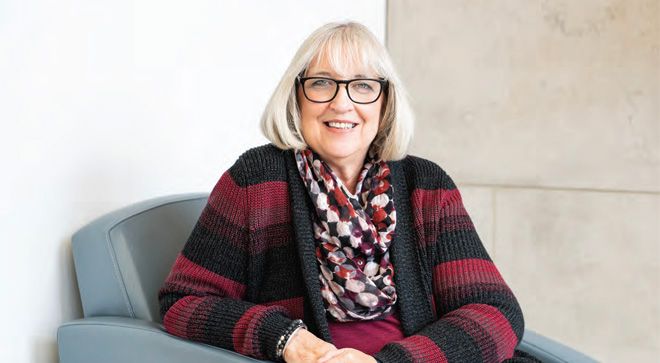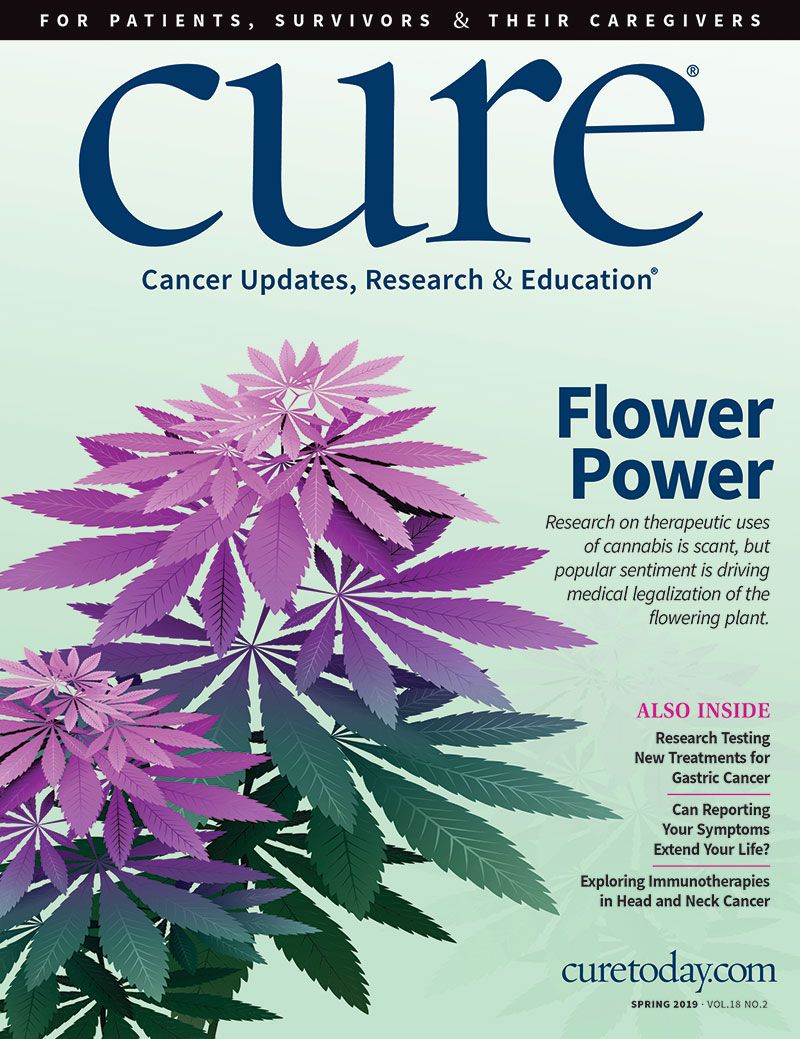Publication
Article
CURE
Patient, Heal Thyself: Those Who Self-Report Symptoms May Live Longer
Author(s):
Patients who self-report their symptoms live longer than those who do not, researchers say. Here’s why and what it means for the future of cancer treatment.
Early in his career, Ethan Basch, M.D., M.Sc., an oncologist and professor of medicine at The University of North Carolina in Chapel Hill, noticed that nearly half the physical and psychological symptoms felt by his patients with cancer went unreported. How, he wondered, could doctors catch these side effects that were slipping through the cracks and better help patients?
While working at Memorial Sloan Kettering Cancer Center in New York City in 2007, Basch began a study of patient-reported outcomes (PROs), dividing 766 people with cancer into groups and following them for three years. During that time, enrollees in one group were reminded by telephone, text or email to rate 10 to 15 side effects and add comments via a web-based, phone-based or tablet system. The other group received typical care.
“When they reported severe or worsening symptoms,” Basch says, “it automatically triggered a message to their nurse via email or within the electronic medical record system, letting them know that the patient was getting into trouble. And then the nurse could respond.”
Researchers found that patients who reported their symptoms felt better and lived an average of five months longer — 31.2 versus 26 months — than those who did not. “At first I was surprised at the magnitude of the benefit, which is greater than (the benefit with) many of the drugs we develop, but, clinically, it makes sense,” Basch says. “We miss many of our patients’ symptoms, and by detecting those symptoms early and intervening before they become severe or cause complications, we can substantially improve outcomes.”
HOW PATIENT-REPORTED SYSTEMS WORK
According to Lori Williams, Ph.D., M.S.N., APRN, an associate professor in the department of symptom research at The University of Texas MD Anderson Cancer Center in Houston, her institution has been working with a patient reporting system called the MD Anderson Symptom Inventory since the 1990s. Original reporting was done on paper but can now be done electronically and prompt reports via tablet, phone, email or patient electronic portal.
“It measures symptom burden in patients with cancer,” Williams says. “First, patients rate the severity of common cancer symptoms, and then (they) rate how much their symptoms are interfering with their ability to function.”
Maintaining a person’s ability to function is important, agrees Ishwaria Subbiah, M.D., M.S., a palliative care physician, medical oncologist and assistant professor at MD Anderson. She works to reduce high symptom burdens in the Supportive Care Center, where 80 percent of patients have advanced cancer.
New patients are asked: “What are the most important parts of your day-to-day life, and how has cancer and cancer treatment affected them?” This information guides the medical team’s practice and intervention for that patient.
Before each appointment, patients use the Edmonton Symptom Assessment Scale (ESAS) to report on 12 common cancer side effects. Patients originally filled out paper forms in the waiting room but now are asked to take online surveys the day before. That was a hard sell at first, Subbiah says, but recently the at-home completion rate jumped from 20 percent to 70 percent.
“It’s a culture change,” Subbiah says, “because the patients are used to filling it out on paper, but we’ve reinforced that they need to do it online. We’re in a time where just about every person is using their electronic medical record in multiple ways, and this is reinforcing that electronic is the preferred option.”
HOW REPORTING HELPS
As the Basch trial showed, PRO systems benefit patients because they help clinicians intervene before symptoms become problematic. Questionnaires can be an excellent way to uncover these symptoms, because they give patients an opportunity to share this information with their doctors without cutting into their appointment time, which they may prefer to devote to discussion about treatments.
PRO systems are being used more widely in Canada than in the United States.
In Ontario, Zahra Ismail is group manager for patient reported outcomes and symptom management at Cancer Care Ontario (CCO), a provincial government agency that is in charge of improving cancer services. Ismail says that the CCO’s web-based PRO system provides regular symptom screening at 14 centers and over 50 hospitals. An average of 30,000 people report their symptoms every month through kiosks located in lobbies. A nurse or physician can review a printout of a report, which includes the patient’s last 20 ratings, before or during an appointment.
“With the symptom report, the clinician can say, ‘I noticed that your nausea went from a 2 to a 5,’” Ismail says. “A 5 may not be considered severe, but that change over time can be significant for that patient. The report gives the clinician the opportunity to discuss the change and intervene appropriately.”
Joanne MacPhail, a patient at the Waterloo Wellington Local Health Integration Network in Ontario who has had two recurrences since receiving a diagnosis of breast cancer in 1993, says PRO systems have made a big difference in her care. “It’s just so important,” MacPhail says. “Oftentimes you don’t get enough time to discuss things with your oncologist. But if they pay attention to your ESAS scores, that opens up the conversation, and it also helps give you some control over what’s going to happen in your appointment.”
One day after a particularly bad lymphedema flare-up that involved three days in the hospital and 10 days with an in-home nursing service, MacPhail went to a follow-up appointment. She was having a hard time taking care of herself and felt anxious, depressed and in pain when she entered her scores. By the time she got home, she had received three calls — from a physical therapist, a social worker and a dietitian.

JOANNE MACPHAIL has found that using patient-reported outcome systems brought her immediate help in dealing with side effects of breast cancer treatment.
SUPPORTING THESE SYSTEMS
Right now, the clinics using PRO systems tie the reports to in-clinic appointments. At some point, will patients be able to rate their symptoms from home between visits?
“Ethan Basch’s study showed that doing routine symptom assessment with clinician follow-up in patients in active treatment, in between visits, helped,” Williams says. “That is the holy grail.”
Subbiah agrees that, ideally, symptoms will be moni­tored between visits. “When someone is going through active cancer treatment,” Subbiah says, “even if their appointments are three weeks apart, their health isn’t static during that time. Things change. We want to know what those changes are and try to nip any symptoms in the bud, to try to put a plan in motion before they get serious. The goal of this system is to provide proactive care continuously, even if the person is not physically in clinic.”
Supporting a system like this requires a new workflow and staff members who are ready to respond any time, day or night. Established rules need to guide when to recommend that someone go to the emergency room and how to handle patients who respond too frequently.
“We’re not currently encouraging patients to fill (a symptom assessment) out at home,” Ismail says. “If a patient reports a severe symptom in the off hours and there isn’t a clinician to review or respond, we’re worried there is a risk that patients will not receive help soon enough. CCO is working on a model of care to support real-time symptom monitoring in the future.”
OBSTACLES TO IMPLEMENTATION
“These systems have showed an improved quality of life and fewer emergency room visits,” Subbiah says. “So, there’s incentive on multiple levels for every stakeholder in a hospital to develop a PRO-based care system.”
Even so, this technology is just catching on in the U.S., according to Karyn Dyehouse, M.D., a medical oncologist and hematologist and chief medical officer at Oncology Hematology Care in Cincinnati. “This is definitely the direction that medicine is going in,” she says. “We see the utility and the value; it’s just that no one has yet developed it. They are not as robust as we need them to be.”
According to Basch, medical centers that want to imple­ment PRO systems must overcome three main obstacles.
Workflow and culture: Today, patients call their care teams when they have a problem. With a PRO system, doctors and nurses reach out to patients, and changing the way health care providers do things is not easy. It requires top-down and bottom-up approval and training for everyone from the front desk staff to the physicians.
Technology: Medical centers need software to collect the information and interface with the electronic health record, so programming resources must be set up.
Patient engagement: The systems need to be uncomplicated and user-friendly so that patients are engaged and motivated to use them.
“With most quality-improvement or value-based care programs that we implement,” Basch says, “the providers or administrators control them. But in this case, the patients are our partners.”
Dyehouse agrees that medical centers need to make the systems easy for patients. “If you have an illness,” she says, “it’s a full-time job managing it, between insurance, bills and prior authorizations. We have to be mindful of what we’re asking, and the health care system needs to take responsibility for gathering and reporting outcomes.”
That is more likely to happen once oncologists are widely sold on the idea, MacPhail suggests. “More doctors need to pay attention to it,” she says. “I think a lot of them are, but I think the importance of this system needs to be empha­sized to the oncologists.”
Once the obstacles are overcome and systems are in place, medical centers may choose to build triage depart­ments to handle severe symptoms between appointments.
THE FUTURE
Maybe at some point, PROs will be part of the standard of care and get the attention of regulatory agencies and policymakers.
In the meantime, CCO will set about establishing PRO measurements that work well for specific diseases. Right now, they use the ESAS that is generalized for most illness.
“There are some diseases, like prostate cancer, where this doesn’t work well,” says Natalie Coburn, M.D., M.P.H., provincial clinical lead for PROs and symptom management at CCO and a surgical oncologist at Sunnybrook Health Sciences Centre in Toronto. “More detail needs to be asked about urinary incontinence and sexual function, and ESAS doesn’t delve into those questions.” To address this gap, CCO has implemented a prostate cancer PRO called EPIC (Expanded Prostate Cancer Index Composite) at the 14 cancer centers.”
CCO is pilot testing “triggering,” which allows the system to follow up with a second questionnaire that contains more specific questions and resources if a patient rates a symptom above a certain level, Ismail says.
Another big question involves what can be learned from all the collected data. Coburn estimates that CCO has data for about 10 million outcome measures. Evaluating this information requires sophisticated analysis but could be useful for predicting things like emergency-room visits. “For example, research has shown that patients who score more than a 7 on their overall well-being have a high likelihood of visiting the (emergency room) in the next seven days,” Ismail says.
Basch notes that his research is headed in the direction of using chatbots (computer programs designed to “converse” with people) and natural language processing technology to analyze and sort free-text comments. He also wants to improve the interface between patients and clinicians, allowing a more conversational interaction that elicits ratings that are turned into standard data that can be sent to doctors.
Basch also sees using information from passive devices (like Fitbits) that measure physical activity and temperature, along with some symptoms, as part of the same evolving field. “However, I think the patient reporting piece is essential,” Basch says, “because most of these things can’t be monitored. You can’t really monitor for nausea or fatigue or pain. Those are highly subjective.”





